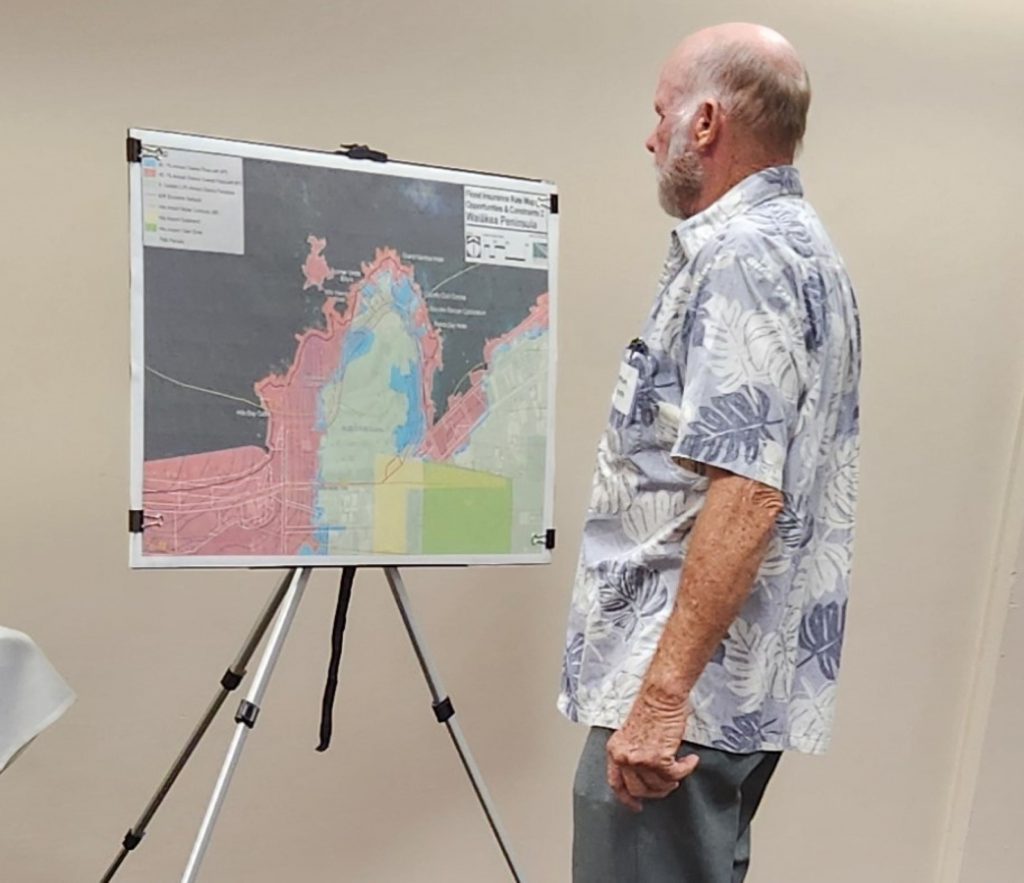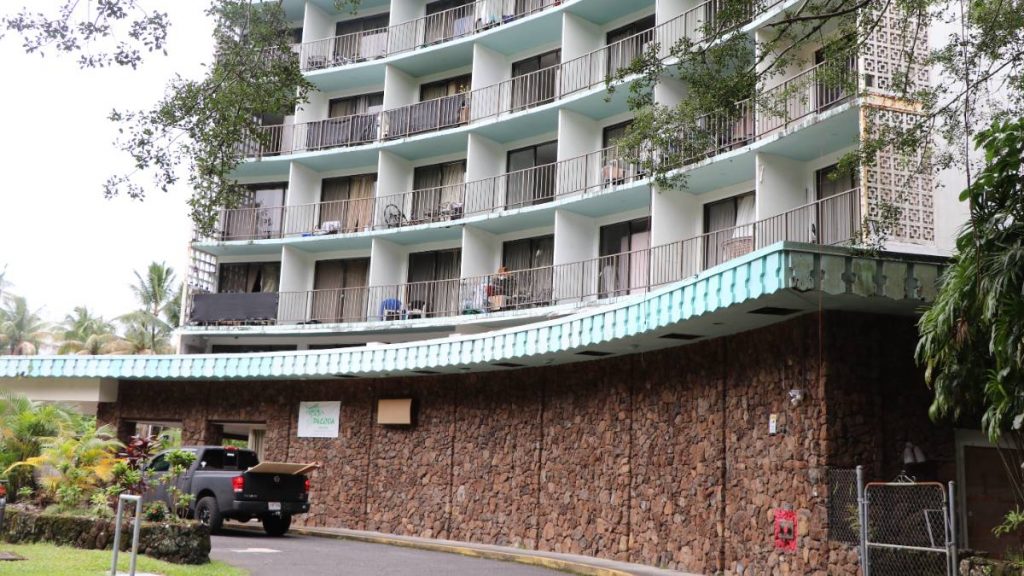Community frustration boils over during public meeting about future of Hilo’s Waiākea Peninsula

At a public meeting Monday night, the Hawai‘i Department of Land and Natural Resources and Hawai‘i Community Development Authority were confronted by a Hilo community frustrated by the slow progress to clean up the blighted area of Waiākea Peninsula and future plans not focusing on its rich culture and history.
State officials were at the Hilo Hawaiian Hotel to hear from the more than 60 community members and local officials about their vision for the East Hawai‘i peninsula, Hilo’s resort hub and home to Lili’uokalani Gardens and historic Banyan Drive.
They also sought input on governance and land stewardship considerations for the area, possible future land uses, and examples of waterfront and other redevelopments elsewhere to help development efforts for the mostly state-owned lands.
A report for the Hawai‘i Legislature is expected to be completed next month.
The meeting went smoothly at the beginning, with a presentation followed by an open house format where the public could engage directly with state officials.
The mood shifted when the discussion changed to economic development, including tourism. Examples of waterfront developments in Florida, New York and New Zealand were shown to see what aspects of those developments, if any, community members might like to see incorporated in the future revitalization of the Waiākea Peninsula.
Outbursts including “This is not Florida” and “nothing similar to Hawai‘i” came from the public, with another community member saying they don’t need to learn about anything from outside the islands.
“We’re hearing tourism, tourism, tourism when we should be hearing kanaka, kanaka, kanaka,” one person said before another asked when officials would actually hear what the community is saying.

One member of the public spoke about the lack of regard for Native Hawaiian remains located on the peninsula, which was once a hub for spiritual and cultural practices, and another said there is a serious lack of cultural sensitivity from the state as to what needs to be addressed on the peninsula.
Ann Bouslog, director of land economics and real estate for PBR Hawai‘i and Associates, the firm hired by the state to help collect community feedback and produce the report to the legislature, admitted that there is a lack of good cultural and historic impact assessments for the area but that any future development would have to consider those aspects.
Preserving the culture and history of the area is a top priority for the majority of the community.
Suggestions put forth by community members during a series of design lab workshops in October and November included more ways to learn about the peninsula’s history and cultural importance, such as building a cultural center and/or museum; having classes, other workshops and forums; and creating an indigenous data center.
There was a feeling of disconnect between the state plans and what the community wants.
The Hawai‘i County Windward Planning Commission in 2016 declared Banyan Drive blighted and several plans to revitalize and redevelop the Waiākea Peninsula have been made since, but movement and progress have been slow, also leading to the community’s frustration.

Momentum finally picked up steam this year after Hawai‘i Gov. Josh Green signed an emergency proclamation in July to help clean up, secure and demolish ground zero for the area’s decline, the former Uncle Billy’s Hilo Bay Hotel property, which closed in 2017 and became a den for illegal activity — squatting, drug use and even arson.
Green signed a second emergency proclamation in September for the former 146-room hotel site. On Nov. 9, the governor extended the relief period again, issuing a third emergency proclamation, which is effective until Jan. 8, 2024.
Asbestos abatement work at the former hotel is underway and demolition is expected to be completed by November 2024.
The state is also moving forward with plans for renovations of the distressed former Country Club Condominiums complex on Banyan Drive, which has languished in disrepair for some time.
“I hear the frustration,” said Craig Nakamoto, Hawai‘i Community Development Authority Executive Director. “But at the same time, I prefer to look forward and say, ‘You know, what is it that we can do?'”
Nakamoto said development is a process and it won’t happen overnight. The issues community members brought up will have to be addressed, especially cultural and historical concerns.
“It’s something we have to pay attention to and we’re still gathering this information tonight,” he said. “We have to consider it as part of the planning.”

Hawai‘i County Councilwoman Sue Lee Loy, who represents the Waiākea Peninsula area, said a lot of the plans the state is trying to refine or take input on seem to be coming from planners in Honolulu and don’t match the sentiments of the Hilo community.
“I too am a little frustrated because I think there was an opportunity to lead with culture,” she said. “When we ground ourselves in a place, we come as our best self and that leads to ripe and rich conversations, and that didn’t happen tonight.”
She was disappointed in some disparaging comments from the community about policymakers such as herself and others who she said have had their noses to the grindstone working on the revitalization of the peninsula for years.
“If it wasn’t for that collaboration with myself, [state] Rep. [Richard] Onishi and [state] Sen. [Lorraine] Inouye, we would not be where we are today,” Lee Loy said. “They’ve done nothing and mismanaged this area for the last 15 years and we got something going in six months.”
Her office is putting together a report about the information, data and community comments from the three design lab workshops she hopes can be integrated into the Hawai‘i Community Development Authority’s report to the legislature to help better inform lawmakers and the Hawai‘i Board of Land and Natural Resources about the community’s vision for the area.
Lee Loy added that there could be more opportunities in the future for the county to take the lead on peninsula properties.
Discussions are already underway for what happens to the former Uncle Billy’s property once the hotel is demolished. With open space and a beach area suggested uses, there might be a possibility the state could transfer the property to the county, which then could care for it as part of its open space fund.
Don Inouye, owner of Hilo Reeds Bay Hotel on Banyan Drive, has been on the peninsula almost daily for nearly the past 30 years. He suggests creating a nonprofit authority for the Banyan Drive area and appointing an executive director to take the reins, similar to the Friends of Lili’uokalani Gardens, which cares for that part of the area now on its own.
“We must immediately enable the beautification of Banyan Drive, restoration of the banyan trees and support, protection and fair treatment of existing Banyan Drive businesses,” Inouye says in a letter he presented to state officials during Monday’s meeting. “We cannot afford to allow the continuing decline of Banyan Drive and suffer the economic disaster that such a loss would constitute for the economy of East Hawai‘i. We require effective action now.”
If you couldn’t make it to Monday’s meeting, you can watch a recording and provide additional feedback by visiting the Hawai‘i Community Development Authority’s Waiākea Peninsula web page or contact the authority at WPmarketstudy@gmail.com.
Comments received by Dec. 13 will be compiled and added to the report to the legislature.
Sponsored Content
Comments














